
Progressive Web Apps (PWAs) have been part of the development conversation for years, but 2025 marks a significant turning point. After a period of steady evolution, PWAs are experiencing a powerful resurgence, driven by key technological advancements and a shift in user expectations. For us as marketers, understanding this trend is crucial. This isn’t just about a new tech fad; it’s about a fundamental change in how users interact with brands online and how we can deliver superior digital experiences.
This post will explore why PWAs are making such a strong comeback. We will cover the core benefits they offer, the recent innovations making them more powerful than ever, and their direct impact on our digital marketing strategies.
What’s Driving the PWA Comeback?
The renewed interest in PWAs isn’t happening in a vacuum. It’s the result of a perfect storm of improved browser support, enhanced device capabilities, and a growing demand for faster, more seamless user experiences. Businesses are tired of the high costs and friction associated with native app development and distribution. Users are tired of downloading another app for every single brand they interact with. PWAs offer the perfect middle ground.
The Best of Both Worlds: App-Like Experience, Web-Based Delivery
At their core, PWAs deliver an app-like experience directly through a web browser. Think of them as a hybrid that combines the discoverability and accessibility of a website with the functionality and immersive feel of a native mobile app.
Key features that make this possible include:
- Installable: Users can add a PWA to their home screen with a single tap, creating a direct access point without going through an app store.
- Offline Functionality: Service workers, a key PWA technology, enable apps to cache data and function even with a poor or non-existent internet connection. This is a game-changer for user retention.
- Push Notifications: PWAs can send push notifications just like native apps, allowing us to re-engage users with timely updates, promotions, and personalized content.
Overcoming the App Store Hurdle
App stores have long been the gatekeepers of mobile experiences. However, the process of getting an app approved and discovered is often long, expensive, and restrictive. PWAs bypass this entirely. They are indexed by search engines, making them discoverable through standard web searches. This aligns perfectly with modern digital marketing efforts, where SEO and content visibility are paramount.
By eliminating the need for an app store download, we remove a significant point of friction in the customer journey. How many potential users have we lost because they didn’t want to commit the time or device space to download a full native app? PWAs solve this problem by offering instant access.
Key Technological Advances Fueling PWAs in 2025
While the core concepts of PWAs aren’t new, recent advancements have supercharged their capabilities, making them a more viable and attractive option than ever before.
Project Fugu and Enhanced APIs
The Web Capabilities project, known as Project Fugu, has been a major catalyst. Led by Google, Microsoft, and other major tech players, its goal is to bring native-level device capabilities to the web. In 2025, the fruits of this project are more apparent than ever.
PWAs can now access a wider range of hardware features, including:
- Advanced Camera Controls: Moving beyond simple photo capture to include controls for zoom, focus, and lighting.
- File System Access: Allowing users to open and save files directly on their local device, making productivity and content creation apps more powerful.
- Bluetooth and NFC: Enabling connectivity with a vast ecosystem of IoT devices and facilitating contactless interactions.
These new APIs close the gap between what a native app can do and what a web app can do, making PWAs suitable for a much broader range of applications.
Improved Performance with WebAssembly (Wasm)
Performance has always been a key selling point for PWAs, and WebAssembly has taken it to the next level. Wasm allows developers to run high-performance code, originally written in languages like C++ or Rust, directly in the browser. This means that computationally intensive tasks, such as video editing, 3D rendering, and complex data analysis, can now run at near-native speeds within a PWA.
This leap in performance makes PWAs a credible alternative for even the most demanding applications, expanding their potential use cases far beyond simple content delivery.
The Impact on Digital Marketing Strategy
The resurgence of PWAs directly affects how we approach digital marketing. They aren’t just a tool for the development team; they are a powerful asset for creating more effective and engaging campaigns.
Enhancing User Engagement and Retention
The combination of push notifications, offline access, and home screen installation creates a powerful loop for user engagement. We can bring users back to our platform without relying on email or paid ads. Imagine sending a notification about a new blog post or a flash sale that a user can open instantly, even if they have a spotty connection on their commute. This level of direct, low-friction communication is a marketer’s dream.
Furthermore, the fast load times and smooth performance of PWAs lead to lower bounce rates and higher time-on-site, which are positive signals for both user experience and SEO.
A Cost-Effective and Unified Approach
Developing and maintaining separate codebases for a website, an iOS app, and an Android app is incredibly resource-intensive. A PWA consolidates these efforts into a single codebase. This not only reduces development and maintenance costs but also ensures a consistent brand experience across all platforms.
For our marketing efforts, this means faster campaign rollouts. A new feature or landing page can be deployed once and is immediately available to all users, regardless of their device. This agility is a significant competitive advantage.
SEO and Discoverability
Since PWAs are fundamentally websites, they are fully indexable by search engines. Every piece of content within the PWA can be a landing page, discoverable through organic search. This is a massive advantage over native apps, whose content is largely invisible to search engines. By optimizing our PWA with solid SEO practices, we can attract a continuous stream of organic traffic. This synergy between PWA technology and digital marketing creates a powerful acquisition channel.
Conclusion: Embracing the PWA Shift
The comeback of Progressive Web Apps in 2025 is not a temporary trend. It’s a strategic response to the evolving demands of users and businesses for faster, more accessible, and more engaging digital experiences. By offering the best of web and mobile in a single, cost-effective package, PWAs are poised to become a central component of modern digital infrastructure.
For our team, this means we must start thinking “PWA-first.” We should evaluate how this technology can enhance our campaigns, improve our customer journeys, and give us a competitive edge. The time to integrate PWAs into our core digital marketing strategy is now. Let’s start the conversation about how we can leverage this powerful technology to achieve our goals.




